Telangana TSBIE TS Inter 1st Year Zoology Study Material 6th Lesson Biology in Human Welfare Textbook Questions and Answers.
TS Inter 1st Year Zoology Study Material 6th Lesson Biology in Human Welfare
Very Short Answer Type Questions
Question 1.
Define parasitism and justify this term.
Answer:
An intimate association between two organisms of different species in which, one is benefited and the other one is often adversely affected is called parasitism. The organism that obtains nourishment is called parasite and the organism from which the nourishment is obtained is called host.
Question 2.
Distinguish between facultative parasite and obligatory parasite.
Answer:
a) Facultative Parasite :
They lead parasitic life on host if available or may lead free living life in its absence.
Example : (Mycobacterium tuberculosus), Ascaris lumbricoides is facultative anaerobe.
b) Obligatory parasite :
They lead total parasitic life on host and in its absence, they die.
Example : (Blood fluke) Taenia solium is an obligatory anaerobe.
Question 3.
Distinguish between definitive host and intermediate host.
Answer:
Definitive host :
It is the host that harbours the adult stage or sexually mature stage of a parasite or the host in which the parasite undergoes sexual reproduction.
Intermediate host :
It is the host that harbours the developing larval or immature or asexual stages of a parasite or the host in which the parasite undergoes asexual reproduction.
Question 4.
Distinguish between vector and a reservoir host.
Answer:
a) Reservoir host :
It is the host that lodges the infective stages of a parasite in its body when the main host is not available. In the reservoir host, the parasite neither undergoes development nor causes any disease.
b) Vector :
It is an organism which transfers the infective stages of a parasite from one main host to another.
Question 5.
Distinguish between mechanical vector and biological vector.
Answer:
a) Mechanical vector :
It is the vector, which merely transfers the infective stages of a parasite but no part of the parasitic development takes place in it.
b) Biological vector :
It is the vector in which the parasite undergoes a part of the development before it gets transferred to another host.
![]()
Question 6.
What is a hyper-parasite? Mention the name of one hyper-parasite.
Answer:
Hyperparasite :
It is a parasite which lives in /on the body of another parasite.
eg : Nosema notabilis (cnidosporan parasite) lives in Sphaerospora polymorpha (also a cnidosporan parasite) which lives in the urinary bladder of toad fish.
Question 7.
What do you mean by parasitic castration? Give one example. [March 2020, 17]
Answer:
Parasitic castration :
Some parasites cause the degeneration of gonads of the host, making it sterile. This effect is called parasitic castration, eg : Sacculina (a crustacean) causes degeneration of ovaries in the crab carcinus.
Question 8.
What are the parasitic adaptations observed in Ascaris lumbricoides?
Answer:
- Developed protective cuticle to withstand the action of digestive enzymes of the host.
- Reproductive potential is high due to risky lifecycle. Ascaris female lays 2 lakhs of eggs per day.
- It is a facultative anaerobe.
Question 9.
What are the endo-parasitic adaptations observed in Fasciola hepatica?
Answer:
Life cycle of Fasciola hepatica is very complex involving many developmental stages and two intermediate hosts to increase the chances of reaching a new definitive host.
Question 10.
Define neoplasia. Give one example.
Answer:
Neoplasia :
Some cause an abnormal growth of the host cells in a tissue to form . new structures. This effect is called Neoplasia which leads to cancers, eg : Some viruses.
Question 11.
Define the most accurate definition of the term ‘health’ and write any two factors that affect the health.
Answer:
Health is a state of complete physical, mental and social well-being and not merely ‘absence of any disease’ or ‘absence of physical fitness’. Two factors that affect the health are 1) contaminated water 2) pollution of air.
Question 12.
Distinguish between infectious and non-infectious diseases. Give two examples each.
Answer:
a) Infectious diseases :
The diseases which are easily transmitted from one person to another are called infectious diseases. Eg. Amoebic dysentery, Malaria,
b) Non – infectious diseases :
The diseases which are not transmitted from one person to another and are not caused by pathogens are called non-infectious diseases.
eg : Kidney problems, genetic disorders, heart problems.
![]()
Question 13.
When can you diagnose a healthy person as unhealthy?
Answer:
When the functioning of one or more organs or systems of the body is adversely affected characterized by various signs and symptoms, we say that we are not healthy or we are unhealthy.
Question 14.
Write any two diagnostic features of trophozoite of Entamoeba histolytica.
Answer:
a) Cartwheel shaped nucleus.
b) Single blunt finger like pseudopodium called lobopodium.
c) Presence of RBC in food vacuole.
Question 15.
‘Entamoeba histolytica is an obligatory anaerobe.’ Justify.
Answer:
The absence of mitochondria indicates the obligate anaerobic nature of Entamoeba histolytica.
Question 16.
Distinguish between precystic stage and cystic stage of E. histolytica.
Answer:
Precystic stage :
It is the non-feeding and non-pathogenic stage of Entamoeba histolytica. It is a small, spherical or oval, non-motile form.
Cystic stage :
It is round in shape and is surrounded by a thin, delicate, and highly resistant cyst wall. This is infective stage.
Question 17.
What is the reserve food in the precystic and early cyst stages of Entamoeba histolytica?
Answer:
The reserve food in the precystic and early cyst stages of Entamoeba histolytica are glycogen granules and chromatoid bars (made up of ribonucleo protein).
![]()
Question 18.
What is a metacystic form with reference to Entamoeba histolytica?
Answer:
When the tetranucleate cysts of entamoeba histolytica enter a new human host, they pass into small intestine where the cyst wall gets ruptured by the action of the enzyme trypsin, releasing the tetranucleate amoebae. Such tetranucleate excystic amoebae are called metacysts.
Question 19.
A person is suffering from bowel irregularity, abdominal pain, blood and mucus in stool /etc. Based on these symptoms, name the disease and its causative organism.
Answer:
The disease is Amoebic dysentery or Amoebiasis. The causative organism is Entamoeba histolytica.
Question 20.
On the advice of a doctor, a patient has gone to a clinical laboratory for the examination of a sample of faeces. The lab technician, on observing the stool of the patient diagnosed that the patient was suffering from amoebiasis. Write any two characteristic features based on which the technician came to that conclusion.
Answer:
- Stools with blood and mucous.
- Stools containing the tetranucleate cysts.
Question 21.
Define ‘asymptomatic cyst passers’ with reference to Entamoeba histolytica.
Answer:
Some people do not exhibit any symptoms of amoebic dysentery or intestinal amoebiasis or tropical amoebiasis. Such people are called carriers or ‘asymptomatic cyst passers’ as their stool contains the tetranucleate cysts.
Question 22.
Distinguish between primary amoebiasis and secondary amoebiasis.
Answer:
- Stools with blood and mucous with acute abdominal pair is generally referred to as primary amoebiasis.
- When trophozoites rupture the wall of capillaries, enter the blood stream, and primarily reach the liver where they may cause abscesses – some call it secondary amoebiasis.
Question 23.
What are the stages of Plasmodium vivax that infect the hepatocytes of man?
Answer:
The stages of plasmodium vivax that infect the hepatocytes of man are
- Sporozoites primarily
- Cryptozoites Secondarily (They are also referred to as I generation merozoites)
Question 24.
What are the stages of Plasmodium vivax that infect the RBC of the intermediate host?
Answer:
The stages of Plasmodium vivax that infect the RBc of the intermediate host are a) Cryptozoites b) Micro-metacryptozoites.
Question 25.
Define prepatent period. What is its duration in the life cycle of Plasmodium vivax?
Answer:
The interval between the first entry of plasmodium into the blood in the form of sporozoites and the second entry of plasmodium into the blood in the form of cryptozoites is called “Prepatent period”. In Plasmodium vivax it is 8 days.
Question 26.
Define incubation period. What is its duration in the life cycle of Plasmodium vivax? [March 2018 – A.P.]
Answer:
The period between the entry of plasmodium into the blood in the form of sporozoites and the first appearance of symptoms of malaria in man is called incubation period. It is approximately 10 to 14 days in Plasmodium vivax.
Question 27.
What are Schuffner’s dots? What is their significance?
Answer:
In the signet ring stage’of malarial parasite small red coloured dots appear in the cytoplasm of the RBC known as Schuffner’s dots. These are believed to be the antigens released by the parasite.
![]()
Question 28.
What are haemozoin granules ? What is their significance?
Answer:
The malaria parasite digests the globin part of the ingested haemoglobin and converts the soluble haem into an insoluble crystalline haemozoin granules. It is called the malaria pigment which is a disposable product.
Question 29.
Distinguish between schizogony and sporogony.
Answer:
- In man the plasmodium reproduces by asexual reproduction called Schizogony. It occurs in liver cells as well as in RBC.
- The formation of sporozoites in the oocysts seen in the stomach wall of female Anopheles mosquito is called SPOROGONY.
Question 30.
What is exflagellation and what are the resultant products called?
Answer:
The formation of male gametes or microgametes by lashing movements like flagella from micro gametocyte is called exflagellation.
Question 31.
Why is the syngamy found in Plasmodium called anisogamy?
Answer:
In plasmodium the male and female gametes are dissimilar in size, the process of union or syngamy is called Anisogamy.
Question 32.
What is ookinete? Based on the ‘sets of chromosomes’ how do you describe it?
Answer:
The zygote remains inactive for some time and then transforms into a long, slender, motile, vermiform ookinete or vermicule within 18 – 24 hours. The ookinete is diploid.
Question 33.
What is tertian fever, with reference to the types of malaria you have learnt about? Give the name of the causative species of the pathogen concerned.
Answer:
Four species of Plasmodium cause four types of malaria in man. They are
a) Plasmodium vivax – benign tertian malaria.
b) Plasmodium falciparum – malignant tertian malaria or cerebral malaria.
c) Plasmodium ovale – mild tertian malaria.
d) Plasmodium malariae-quartan malaria.
Recurrent fever of Malaria is called tertian fever.
![]()
Question 34.
What is the significance of hypnozoites, with reference to malaria fever?
Answer:
Some of the stages of macro-metacryptozoites may survive for a long period in liver as dormant stages called HYPNOZOITES. Reactivation of these hypnozoites leads to the initiation of fresh erythrocytic cycles resulting in the new attacks of malaria. This is referred to as relapse of malaria.
Question 35.
A person is suffering from chills and shivering and high temperature. These symptoms arp cyclically followed by profuse sweating and return to normal body temperature. Based on these symptoms, name the disease and its causative organism.
Answer:
a) Malaria is the disease; b) Causative organism Plasmodium.
Question 36.
Describe the methods of biological control of mosquitoes.
Answer:
Biological control of mosquitoes :
Introduction of larvivorous fishes like Gambusia, insectivorous plants like utricularia into the places where mosquitoes breed.
Question 37.
The eggs of Ascaris are called ‘mammillated eggs’. Justify.
Answer:
In Ascaris each egg is surrounded by a protein coat with rippled surface. Hence the eggs of Ascaris are described as “mammillated eggs”.
Question 38.
Write the route of extra intestinal migration followed by the juveniles of Ascaris lumbricoides.
Answer:
Extra intestinal migration exhibited by 2nd stage larva of Ascaris.

Question 39.
Write any two differences between male and female worms of Wuchereria bancrofti.
Answer:
Wuchereria bancrofti male and female differences.
a) Male worm :
Its posterior end is curved with a cloacal aperture. A pair of unequal, chitinous pineal spicules or copulatory spicules is present in the cloacal region.
b) Female worm :
Its posterior end is straight. Anus is present near the posterior end. The female genital pore or vulva is present mid ventrally at about one third the length from the mouth. It is ovi viviparous.
Question 40.
What is meant by nocturnal periodicity with reference to the life history of a nematode parasite you have studied?
Answer:
The microfilaria larvae of Wuchereria bancrofti in man move in the peripheral blood circulation during the night time between 10 pm and 4 am. This tendency is referred to as NOCTURNAL PERIODICITY.
![]()
Question 41.
Distinguish between lymphadenitis and lymphangitis.
Answer:
- Inflammation in the lymph vessels is called lymphangitis.
- Inflammation in the lymph glands is called lymphadenitis. Both are caused by filarial worm injection.
Question 42.
‘Elephantiasis is the terminal condition of filariasis.’ Justify.
Answer:
Fibroblasts accumulate in these tissues and form the fibrous tissue. In severe cases, the sweat glands of the skin in the affected regions disintegrate and the skin becomes rough. This terminal condition is referred to as Elephantiasis.
Question 43.
Mention the pathogens that cause ringworm.
Answer:
Ringworm is one of the most common infectious diseases in man. It is caused by many fungi belonging to the genera Microsporum, Trichophyton and Epidermophyton.
Question 44.
Explain any three preventive measures to control microbial infections.
Answer:
- The immunization programmes by the use of vaccines have enabled us to completely eradicate a deadly disease like smallpox.
- Biotechnology is at the verge of making available newer and safer vaccines.
- Discovery of antibiotics and various other drugs has also enabled us to treat infectious diseases effectively.
Question 45.
“Maintenance of personal and public hygiene is necessary for prevention and control of many infectious diseases.” Justify the statement giving suitable examples.
Answer:
The following hygienic habits help prevent spread of this disease.
a) Using boiled and filtered water
b) Washing hands, fruits and vegetables properly
c) Using septic tank toilets
These habits prevent diseases like Amoebiasis and Ascariasis.
![]()
Question 46.
Diseases like amoebic dysentery, ascariasis, typhoid etc., are more common in overcrowded human settlements. Why?
Answer:
In overcrowded human settlements, poor sanitation facilities are seen. No septic toilets for defecation. Drinking water is only from available water sources like tanks, lakes and ponds where cleaning of cattle, washing of clothes is also done. Due to these conditions the contaminated water, food and air spread the diseases like typhoid, amoebic dysentery and ascariasis.
Question 47.
In which way does tobacco affect the respiration? Name the alkaloid found in tobacco : [May 2017 – A.P.]
Answer:
Tobacco is smoked or chewed as gutkha or used in the form of snuff. Smoking increases the carbon monoxide level and reduces the oxygen level in the blood. Alkaloid found in tobacco is NICOTINE.
Question 48.
Define drug abuse.
Answer:
When drugs are taken for a purpose other than the medicinal use or in excess amounts that impair one’s physical or psychological functions, it constitutes “drug abuse”.
Question 49.
From which substances ‘Smack’ and ‘Coke’ are obtained?
Answer:
Smack and coke are obtained from :
Smack is chemically diacetylmorphine obtained by the acetylation of morphine extracted from dried latex of unripe seed capsule of poppy plant. Coke or crack is obtained from coca plant Erythroxylum coca, commonly called cocaine.
Question 50.
‘Many secondary metabolites of plants have medicinal properties. It is their misuse that creates problems.’ Justify the statement with an example.
Answer:
Benzodiazepines (tranquilizers), Lysergic acid diethyl amides (LSD) and other similar drugs, normally used as medicines to treat patients with mental illnesses like depression are often abused.
Question 51.
Write the scientific names of any two plants with hallucinogenic properties.
Answer:

Question 52.
Why are cannabinoids and anabolic steroids banned in sports and games?
Answer:
Cannabinoids and anabolic steroids (AAS) increase protein synthesis within cells which result in the build up of cellular tissues, especially in muscles. Cannabinoids show their effects on cardio-vascular system of the body. Hence they are banned in sports and games (DOPING TEST). They give tremendous energy temporarily.
![]()
Question 53.
Mention the names of any four drugs which are used as medicines to treat patients with mental illness like depression, insomnia, etc.’ that are often abused.
Answer:
- Lysergic acid diethyl amides (LSD)
- Barbiturates (sleeping pills)
- Amphetamines
- Benzodiazepines (tranquilizers)
Short Answer Type Questions
Question 1.
What is the need for parasites to develop special adaptations? Mention some special adaptations developed by the parasites. [May 2017 – A.P.]
Answer:
Parasites have evolved special adaptations to meet the requirements and lead successful life in the hosts.
- In order to live in the host, some parasites have developed structures like hooks, suckers, rostellum, etc., for anchoring, e.g. Taenia solium.
- Some intestinal parasites have developed protective cuticle to withstand the action of the digestive enzymes of the host. e.g. Ascaris lumbricoides.
- Some intestinal parasites produce anti enzymes to neutralize the effect of host’s digestive enzymes, e.g. Taenia solium.
- Some parasites live as obligatory anaerobes as the availability of oxygen is very rare for them. e.g. Entamoeba histolytica, Taenia solium, etc.
- Some intestinal parasites live as facultative anaerobes i.e., if oxygen is not available, they live anaerobically and if oxygen is available, they respire aerobically, e.g. Ascaris lumbricoides.
- The morphological and anatomical features are greatly simplified while emphasizing their reproductive potential. For example, an Ascaris lays nearly two lakh eggs per day. In Taenia solium the body is divided into 700 to 900 proglottids of which each proglottid acts as a unit of reproductive system and releases approximately 35,000 eggs.
- The life cycles of endoparasites are more complex because of their extreme specialization. For example, life cycle of certain parasites like Fasciola hepatica (sheep liver fluke) is very complex involving many developmental stages and two intermediate hosts to increase the chances of reaching a new definitive host.
- Certain parasites like Entamoeba develop cysts to tide over the unfavourable conditions like desiccation while reaching the new host.
- Some parasites elude production of vaccines against them (smart parasites!) as they keep changing their surface antigens form time to time.
e.g. Plasmodium, HIV, etc.
Question 2.
Describe the effects of parasites on the host.
Answer:
Effects of parasites on hosts :
In general, the parasites cause weakening of the body of their hosts by causing the deprivation of nutrients, fluids and metabolites as they compete with their hosts for the same. They may also cause pathological effects in their hosts suchas
1) Parasitic castration :
Some parasites cause the degeneration of gonads of the host, making it sterile. This effect is called parasitic castration.
e.g. Sacculina (root headed barnacle, a crustacean) causes the degeneration of ovaries in the crab Carcinus maenas.
2) Neoplasia :
Some cause an abnormal growth of the host cells in a tissue to form new structures. This effect is called neoplasia which leads to cancers, e.g. Some viruses
3) Gigantism :
Some parasites cause an abnormal increase in the size of the host. This effect is called gigantism, e.g. The larval stages of Fasciola hepatica cause gigantism in snail (an intermediate host).
4) Hyperplasia :
Some parasites cause an increase in the number of cells. This effect is called hyperplasia, e.g. Fasciola hepatica in the bile ducts of sheep.
5) Hypertrophy :
Some parasites cause an abnormal increase in the volume / size of the infected host cells. This effect is called hypertrophy, e.g. RBC of man infected by Plasmodium.
6) Most of the parasites cause various types of diseases like
- African sleeping sickness by Trypanosoma gambiense
- Delhi boils / Tashkent ulcers / Oriental sores by Leishmania tropica
- Kala azar/ Dum dum fever/Visceral leishmaniasis by Leishmania donovani
- Malaria by Plasmodium sps
- Elephantiasis by Wuchereria bancrofti.
Question 3.
Distinguish between hypertrophy and hyperplasia with an example [March 2020]
Answer:
Hyperplasia :
Some parasites cause an increase in the number of cells. This effect is called hyperplasia, e.g. Fasaola hepatica in the bile ducts of sheep Hypertrophy: Some parasites cause an abnormal increase in the volume / size of the infected host cells. This effect is called hypertrophy, e.g. RBC of man infected by Plasmodium
![]()
Question 4.
Write any four types of parasitic diseases. Mention the primary and secondary hosts of these parasites.
Answer:
- Malaria caused by Plasmodium. Primary host – female Anopheles mosquito. Secondary host-man.
- Elephantiasis caused by wuchereria bancrofti. Primary host – man. Secondary host – female culex mosquito.
- Amoebic dysentery or Anoebiasis caused by Entamoeba histolytica. Single host -man.
- Ascariasis caused by Ascaris lumbricoides. Single host – man.
Question 5.
Describe the structure of a trophozoite of Entamoeba histolytica.
Answer:
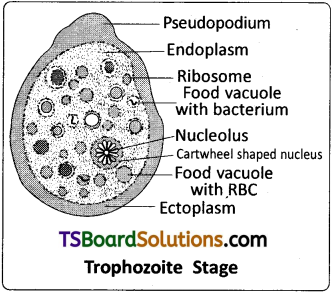
Trophozoite stage :
It is the most active, motile, feeding and pathogenic stage that lives in the mucosa and sub-mucosa membranes of the large intestine. It moves with the help of a single blunt finger like pseudopodium called lobopodium which is produced anteriorly. The body of the trophozoite is surrounded by plas- malemma. Its cytoplasm is differentiated into an outer clear, viscous, non-granular ectoplasm and the inner fluid like, granular endoplasm. Ribosomes, food vacuoles and a vesicular, cartwheel shaped nucleus are present in the endoplasm. However contractile vacuoles, endoplasmic reticulum, Golgi apparatus and mitochondria are absent.
The absence of mitochondria indicates the ‘obligate anaerobic nature’ of Entamoeba histolytica. It produces the proteolytic enzyme called histolysin due to which the species name histolytica’ was assigned to it. Due to the effect of this enzyme, the mucosa and sub-mucosa of the gut wall are dissolved releasing some amount of blood, tissue debris which are ingested by the trophozoites. Hence, the food vacuoles are with erythrocytes, fragments of epithelial cells and bacteria. The mode of nutrition is holozoic. Presence of ‘RBC in food vacuoles’ and cartwheel shaped nucleus are the characteristic features of the trophozoites of Entamoeba histolytica.
Question 6.
Explain the life cycle of Entamoeba histolytica.
Answer:
Life cycle :
The trophozoites undergo binary fissions in the wall of the large intestine and produce a number of daughter entamoebae. They feed upon the bacteria and the host’s tissue elements, grow in size and again multiply. After repeated binary fissions, when the trophozoites increase in number, some of the young ones enter the lumen of the large intestine and transform into precystic stages. Here, the precystic stages transform into cystic stages which in turn develop into tetranucleate cysts.
The entire process is completed only in a few hours. These tetranucleate cysts come out along with the faecal matter and can remain alive for about 10 days. These cysts reach new host through contaminated food and water. They pass into the small intestine of a new human host where the cyst wall gets ruptured by the action of the enzyme trypsin, releasing the tetranucleate amoebae. Such tetranucleate excystic amoebae are called metacysts.
The four nuclei of the metacyst undergo mitotic divisions and produce eight nuclei. Each nucleus gets a bit of the cytoplasm and thus eight daughter entamoebae or ‘metacystic trophozoites’ are produced. These young ones develop into feeding stages called trophozoites. They invade the mucous membrane of the large intestine and grow into mature trophozoites.
Question 7.
Write a short note on the pathogenicity of Entamoeba histolytica.
Answer:
The trophozoites ‘dissolve’ the mucosal lining by histolysin, go deep into sub¬mucosa and cause ulcers. These ulcers contain cellular debris, lymphocytes, blood corpuscles and bacteria. It leads to the formation of abscesses in the wall of large intestine. Ultimately it results in stool with blood and mucous. This condition is called amoebic dysentery or intestinal amoebiasisor tropical amoebiasis. Some people do not exhibit any symptoms. Such people are called ‘carriers or asymptomatic cyst passers’ as their stool contains the tetranucleate cysts. They help in spreading the parasites to other persons.
Extra-intestinal amoebiasis:
Sometimes, the trophozoites may rupture the wall of capillaries, enter the blood stream and primarily reach the liver where they may cause ‘abscesses’ (some call it ‘secondary amoebiasis’). From there, they may go to lungs, heart, brain, kidneys, gonads, etc., and cause abscesses in those parts leading to severe pathological conditions.
![]()
Question 8.
Describe the structure of sporozoite of Plasmodium vivax.
Answer:
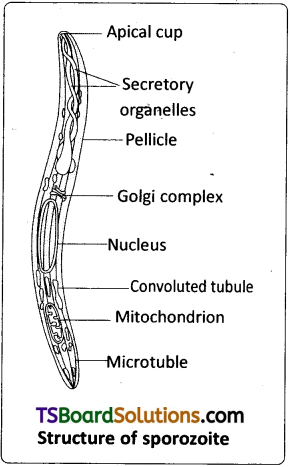
Structure of sporozoite :
It is sickle shaped with a swollen middle part and pointed at both ends of its body. It measures about 15 microns in length and one micron in width. The body is covered by an elastic pellicle with microtubules which help in the wriggling movements of the sporozoite. The cytoplasm contains cell organelles such as Golgi complex, endoplasmic reticulum, mitochondria and a nucleus. Cytoplasm also shows many convoluted tubules of unknown function throughout the length of the body. It contains a cup like depression called apical cup at the anterior end into which a pair of secretory organelles opens. They secrete a cytolytic enzyme, which helps in the penetration of sporozoite into the liver cells.
Question 9.
What do you know about the exo-erythrocytic cycle of plasmodium vivax?
Answer:
This is a part of the life cycle of Plasmodium taking place in the liver of man. This starts after the liberation of cryptozoites from ruptured liver cells. Exo-erythrocytic cycle: If the cryptozoites enter the fresh liver cells, they undergo the changes similar to that of the pre-erythrocytic cycle and produce the second generation merozoites called metacryptozoites. These are of two types – the smaller micro-metacryptozoites and larger macro-metacryptozoites. This entire process is completed approximately in two days. The macro-metacryptozoites attack fresh liver cells and continue another exo-erythrocytic cycle, whereas the micro- metacryptozoites always enter blood stream and attack fresh RBC to continue erythrocytic cycle.
Question 10.
Describe the cycle of Golgi in the life history of Plasmodium vivax.
Answer:
Erythrocytic cycle :
Itwas first described by Camillo Golgi. Hence it is also called Golgi cycle. This cycle is initiated either by the cryptozoites of pre-erythrocytic cycle or the micro-metacryptozoites of exo-erythrocytic cycle. In the fresh RBC, these stages assume spherical shape and transform into trophozoites. It develops a small vacuole which gradually enlarges in size, pushing the cytoplasm and nucleus to the periphery. Now the Plasmodium looks like a finger ring. Hence this stage is called signet ring stage. Soon it loses the vacuole, develops pseudopodia and becomes amoeboid stage. With the help of pseudopodia, it actively feeds on the contents of the RBC and increases in size. As a result, the RBC grows almost double the size, this process is called hypertrophy.
The malaria parasite digests the globin part of the ingested haemoglobin and converts the soluble haem into an insoluble crystalline haemozoin. It is called the ‘malaria pigment’ which is a disposable product. During this stage, small red coloured dots appear in the cytoplasm of the RBC known as Schuffner s dots. These are believed to be the antigens released by the parasite. Now the Plasmodium loses the pseudopodia, further increases in size, occupies the entire RBC and becomes a schizont. It undergoes schizogony similar to that of the pre-erythrocytic cycle and produces 12 to 24 erythrocytic merozoites. They are arranged in the form of the petals of a rose in the RBC. Hence, this stage is called the rosette stage. Finally the erythrocyte bursts and releases the merozoites along with haemozoin into the blood. This cycle is completed approximately in 48 hours.
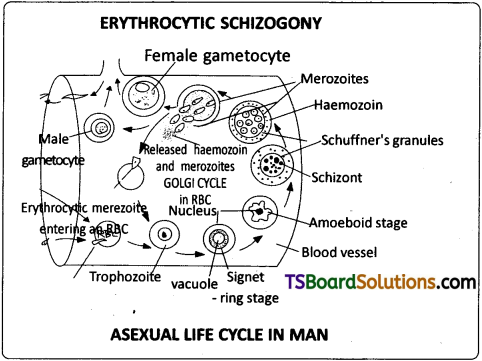
Question 11.
Describe the process of sporogony in the life cycle of Plasmodium vivax. What is the significance of sporozoites?
Answer:
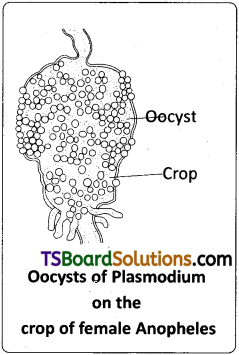
Sporogony :
The formation of sporozoites in the oocysts is called sporogony. According to Bano, the nucleus of the oocyst first undergoes reduction division followed by repeated mitotic divisions resulting in the formation of about 1,000 daughter nuclei. Each bit of nucleus is surrounded by a little bit of the cytoplasm and transforms into a sickle shaped sporozoite. Oocyst with such sporozoites is called sporocyst. When this sporocyst ruptures, the sporozoites are liberated into the haemocoel of the mosquito. From there, they travel into the salivary glands and are ready for infection. The life cycle of Plasmodium in mosquito is completed in about 10 to 24 days.
![]()
Question 12.
Explain the pathogenicity of Wuchereria bancrofti in man.
Answer:
Pathogenicity of Wuchereria bancrofti in man :
Light infection causes filarial fever which is characterised by headache, mental depression and increase in the body temperature. In general, the infection of filarial worm causes inflammatory effect in lymph vessels and lymph glands. Inflammation in the lymph vessels is called lymphangitis and that of lymph glands is called lymphadenitis.
In the case of heavy infection, the accumulation of dead worms blocks the lymph vessels and lymph glands resulting in immense swelling. This condition is called lymphoedema which is noticed in the extremities of limbs, scrotum of males and mammary glands in females. Fibroblasts accumulate in these tissues and form the fibrous tissue. In severe cases, the sweat glands of the skin in the affected regions disintegrate and the skin becomes rough. This terminal condition is referred to as elephantiasis.
Question 13.
Write short notes on typhoid fever and its prophylaxis.
Answer:
Typhoid fever :
It is caused by Salmonella typhi which is a Gram negative bacterium. It mainly lives in the small intestine of man and then migrates to other organs through blood. It can be confirmed by Widal test.
Mode of infection :
Contamination through food and water.
Symptoms :
Sustained fever with high temperature upto 104 F, weakness, stomach pain, constipation, headache and loss of appetite. Intestinal perforation and death may also occur in severe cases.
Prophylaxis :
The immunization programmes by the use of vaccines have enabled us to completely eradicate a deadly disease like smallpox. Biotechnology is at the verge of making available newer and safer vaccines. Discovery of antibiotics and various other drugs has also enabled us to treat infectious diseases effectively.
Question 14.
Write short notes on pneumonia and its prophylaxis.
Answer:
Pneumonia :
It is caused by Gram positive bacteria such as streptococcus pneumoniae and Haemophilus influenzae. They infect the alveoli of lungs in human beings.
Mode of infection :
Contamination by inhaling the droplets / aerosols released by an infected person or even by sharing the utensils with an infected person.
Symptoms :
The alveoli get filled with fluid leading to severe problems in respiration. In severe cases, the lips and finger nails may turn gray to bluish in colour.
Prophylaxis :
The immunization programmes by the use of vaccines have enabled us to completely eradicate a deadly disease like smallpox. Biotechnology is at the verge of making available newer and safer vaccines. Discovery of antibiotics and various other drugs has also enabled us to treat infectious diseases effectively.
![]()
Question 15.
Write short notes on common cold and its prophylaxis.
Answer:
Common cold :
It is caused by Rhino virus group of viruses. They infect nose and respiratory passage but not lungs.
Mode of infection :
Contamination by direct inhalation of the droplets resulting from cough or sneezes of an infected person or indirectly through contaminated objects such as pens, books, cups, door-knobs, computer keyboard or mouse etc. Generally all the medicines that are used against cold cause drowsiness.
Symptoms :
Nasal congestion, discharge from nose, sore throat, hoarseness, cough, headache, tiredness, etc., which usually last for 3 – 7 days.
Prophylaxis :
The immunization programmes by the use of vaccines have enabled us to completely eradicate a deadly disease like smallpox. Biotechnology is at the verge of making available newer and safer vaccines. Discovery of antibiotics and various other drugs has also enabled us to treat infectious diseases effectively.
Question 16.
Write short notes on ‘ringworm’ and its prophylaxis.
Answer:
Ringworm :
It is one of the most common infectious diseases in man. It is caused by many fungi belonging to the genera Microsporum, Trichophyton, and Epidermophyton. Heat and moisture help these fungi grow in the skin folds such as those in the groin or between the toes.
Mode of infection :
Contamination by using towels, clothes or combs of the infected persons or even from soil.
Symptoms :
Appearance of dry, scaly, usually round lesions accompanied by intense itching on various parts of the body such as skin, nails and scalp.
Prophylaxis :
Using of antifungal drugs like Griesoven orally, and antifungal creams like Zole, Itchguard. Ring guard for external tise’cures the disease. Hygiene habits prevent the disease.
Question 17.
What are the adverse effects of tobacco?
Answer:
Tobacco has been used by human beings for more than 400 years. It contains a large number of chemical substances including nicotine, an alkaloid. While buying cigarettes one cannot miss the statutory warning present on the packet Smoking is injurious to health.
Mode of abuse :
It is smoked or chewed as gutkha or used in the form of snuff.
Effect :
Smoking increases the carbon monixide (CO) level and reduces the oxygen level in the blood. Nicotine stimulates the adrenal gland to release adrenaline and nor-adrenaline into blood. These hormones raise the blood pressure and increase the heart rate. Smoking is associated with bronchitis, emphysema, coronary heart disease, gastric ulcer and increases the incidence of cancers of throat, lungs, urinary bladder etc. Smoking also paves the way to hard drugs. Yet, smoking is very prevalent in society, both among young and old. Tobacco chewing is associated with increased risk of cancer of the oral cavity.
![]()
Question 18.
Write short notes on opioids.
Answer:
Opioids :
These are the drugs obtained from opium poppy plant Papaver somniferum (vernacular name : Nallamandu mokka).
They bind to specific opioid receptors present in our central nervous system and gastrointestinal tract. Some of them are morphine, heroin, etc.
i) Morphine :
It is extracted from the dried latex of the unripe seed capsule (pod) of poppy plant. It occurs as colourless crystals or a white crystalline powder.
Mode of abuse :
Generally it is taken orally or by injection.
Effect :
It is a very effective sedative and painkiller. It is very useful in patients who have undergone surgery.
ii) Heroin :
It is a white, bitter, odourless and crystalline compound, obtained by the acetylation of morphine. Chemically it is diacetylmorphine. It is commonly called ‘smack’.
Mode of abuse :
Generally it is taken by snorting and injection.
Effect :
Heroin is a depressant and slows down the body functions.
Question 19.
Write short notes on Cannabinoids.
Answer:
Cannabinoids :
These are a group of chemicals obtained from Indian hemp plant Cannabis sativa (vernacular name: Ganjai mokka). They interact with cannabinoid receptors present in the brain. The flower tops, leaves and the resin of this plant are used in various combinations to produce marijuana, hashish, charas and ganja. These days, cannabinoids are being abused by even some sports-persons (doping).
Mode of abuse :
These are generally taken by inhalation and oral ingestion.
Effect :
Show their effects on cardiovascular system of the body.
Question 20.
Write short notes on Cocaine.
Answer:
Coca alkaloid or Cocaine :
It is a white, crystalline alkaloid that is obtained from the leaves of Coca plant Erythroxylum coca, native to South America. It is commonly called coke or crack.
Mode of abuse :
It is usually snorted.
Effect :
It has a potent stimulating action on the central nervous system as it interferes with the transport of the neuro transmitter dopamine. Hence it produces a sense of euphoria and increased energy. Its excessive dosage causes hallucinations. Other well-known plants with hallucinogenic properties are Atropa belladonna and Datura. Certain drugs like ‘Barbiturates (sleeping pills), Amphetamines (cause sleeplessness), Benzodiazepines (tranquilizers), Lysergic acid diethyl amides (LSD) and other similar drugs, normally used as medicines to treat patients with mental illnesses like depression, insomnia, etc.,1 are often abused.
Question 21.
Why is adolescence considered vulnerable phase?
Answer:
Adolescence :
It is the time period between the beginning of puberty and the beginning of adulthood. In other words, it is the bridge linking childhood and adulthood. The age between 12 -18 years is considered adolescence period. It is both ‘a period and a process’ during which a child becomes mature. It is accompanied by several biological and behavioural changes. Thus, adolescence is a very vulnerable phase of mental and psychological development of an individual.
![]()
Question 22.
Why do some adolescents start taking drugs? How can this be avoided?
Answer:
Curiosity, desire for adventure and excitement, experimentation, are the common causes for the motivation of youngsters towards the use of tobacco, drugs. The first use of drugs or alcohol may be out of curiosity or experimentation, but later the person starts using them to escape facing problems. Recently ‘stress from the pressure to excel in academics or examination’s has played a significant role in alluring the youngsters to try certain drugs. Television, movies, newspapers and internet also help promoting this wrong perception. Other factors that are associated with tobacco, drug and alcohol abuse among adolescents are unstable or unsupportive family structures and peer pressure.
A lot of help is available in the form of highly qualified psychologists, psychiatrists and de-addiction and rehabilitation programmers. Educating and counselling the adolescents to face problems, stress and failures as a part of life.
Question 23.
Distinguish between addiction and dependence. [March 2017 -A.P.]
Answer:
Addiction :
It is a psychological attachment to certain effects such as euphoria. The most important thing one fails to realise is, the inherent addictive nature of tobacco, drugs and alcohol. With the repeated use of TDA, the tolerance level of the receptors present in our body increases. Consequently the receptors respond only to higher doses leading to greater intake and addiction.
However it should be clearly borne in mind that use of TDA even once, can be a fore-runner to addiction. Thus, the addictive potential of tobacco, drugs’and alcohol pull the users into a vicious circle leading to their regular use (abuse) from which they may not be able to get out. In the absence of any guidance or counseling, people get addicted and become dependent on them.
Dependence :
It is the tendency of the body to manifest a characteristic and unpleasant condition (withdrawal syndrome) if the regular dose of drugs or alcohol is abruptly discontinued. The withdrawal syndrome is characterised by anxiety, shakiness (tremors), nausea and sweating which may be relieved when the regular use is resumed again. Dependence leads the patients to ignore all social norms.
Question 24.
“Prevention is better than cure.” Justify with regard to TDA abuse. [March 2018 – A.P.]
Answer:
Prevention and Control: The age-old adage of Prevention is better than cure holds true here also. Some of the measures useful for prevention and control of TDA abuse among the adolescents are :
i) Avoid undue parental pressure :
Every child has his / her own choice, capacity and personality. The parents should not force their children to perform beyond their capacity by comparing them with others in studies, games, etc.
ii) Responsibility of parents and teachers :
They should look for the danger signs and counsel such students who are likely to get into the ‘trap’.
iii) Seeking help from peers :
If peers find some one abusing drugs or alcohol, immediately it should be brought to the notice of their parents or teachers so that they can guide them appropriately.
iv) Education and counselling :
Educating and counselling the children to face problems, stress and failures as a part of life.
v) Seeking professional and medical help :
A lot of help is available in the form of highly qualified psychologists, psychiatrists and de-addiction and rehabilitation programmers.
Essay Answer Type Questions
Question 1.
Explain the structure and life cycle of Entamoeba histolytica with the help of neat and labelled diagrams.
Answer:
Structure: Entamoeba histolytica passes through three distinct stages in its life cycle, namely:
- Trophozoite stage
- Precystic stage and
- Cystic stage

Trophozoite stage :
It is the most active, motile, feeding and pathogenic stage that lives in the mucosa and sub-mucosa membranes of the large intestine. It moves with the help of a single blunt finger like pseudopodium called lobopodium which is produced anteriorly. The body of the trophozoite is surrounded by plasmalemma. Its cytoplasm is differentiated into an outer clear, viscous, non-granular ectoplasm and the inner fluid like, granular endoplasm. Ribosomes, food vacuoles and a vesicular, cartwheel shaped nucleus are present in the endoplasm. However contractile vacuoles, endoplasmic reticulum, Golgi apparatus and mitochondria are absent.
The absence of mitochondria indicates the ‘obligate anaerobic nature’ of Entamoeba histolytica. It produces the proteolytic enzyme called histolysin due to which the species name histolytica’ was assigned to it. Due to the effect of this enzyme, the mucosa and sub-mucosa of the gut wall are dissolved releasing some amount of blood, tissue debris which are ingested by the trophozoites. Hence, the food vacuoles are with erythrocytes, fragments of epithelial cells and bacteria. The mode of nutrition is holozoic. Presence of ‘RBC in food vacuoles’ and cartwheel shaped nucleus are the characteristic features of the trophozoites of Entamoeba histolytica.
Precysticstage :
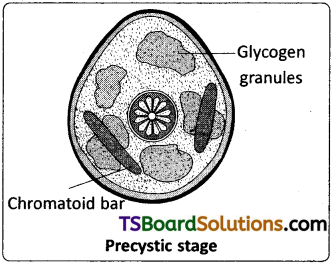
It is the non-feeding and non-pathogenic stage of Entamoeba histolytica that is found in the lumen of the large intestine. It is a small, spherical or oval, non- motile form. The cytoplasm of the precystic stage stores glycogen granules and chromatoid bars (made of ribonucleo protein) which act as reserve food.
Cystic stage :
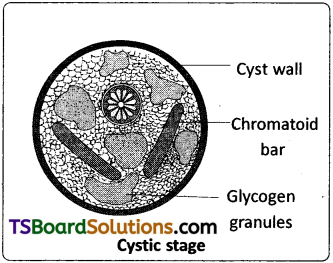
It is round in shape and is surrounded by a thin, delicate and highly resistant cyst wall. It is found in the lumen of the large intestine. The process of development of cyst wall is called encystation which is a means to tide over the unfavourable conditions that the parasite is going to encounter while passing to a new host. Soon after the encystation, the nucleus undergoes two successive mitotic divisions to form four daughter nuclei. This type of cystic stage is called tetra nucleate cyst or mature cyst which is ‘the stage infective to man’.
Life cycle :
The trophozoites undergo binary fissions in the wall of the large intestine and produce a number of daughter entamoebae. They feed upon the bacteria and the host’s tissue elements, grow in size and again multiply. After repeated binary fissions, when the trophozoites increase in number, some of the young ones enter the lumen of the large intestine and transform into precystic stages. Here, the precystic stages transform into cystic stages which in turn develop into the tetranucleate cysts.
The entire process is compelted only in a few hours. These tetranucleate cysts come out along with the faecal matter and can remain alive for about 10 days. These cysts reach new host through contaminated food and water. They pass into the small intestine of a new human host where the cyst wall gets ruptured by the action of the enzyme trypsin, releasing the tetranucleate amoebae. Such tetranucleate excystic amoebae are called metacysts.
The four nuclei of the metacyst undergo mitotic divisions and produce eight nuclei. Each nucleus gets a bit of the cytoplasm and thus eight daughter entamoebae or ‘metacystic trophozoites’ are produced. These young ones develop into feeding stages called trophozoites. They invade the mucous membrane of the large intestine and grow into mature trophozoites.
Pathogenicity :
The trophozoites ‘dissolve’ the mucosal lining by histolysin, go deep into sub¬mucosa and cause ulcers. These ulcers contain cellular debris, lymphocytes, blood corpuscles and bacteria. It leads to the formatjon of abscesses in the wall of large intestine . Ultimately it results in stool with blood and mucous. This condition is called amoebic dysentery or intestinal amoebiasis or tropical amoebiasis. Some people do not exhibit any symptoms. Such people are called ‘carriers or asymptomatic cyst passers’ as their stool contains the tetranucleate cysts. They help in spreading the parasites to other persons.
Extra-intestinal amoebiasis :
Sometimes, the trophozoites may rupture the wall of capillaries, enter the blood stream, and primarily reach the liver where they may cause ‘abscesses’ (some call it ‘secondary amoebiasis’). From there, they may go to lungs, heart, brain, kidneys, gonads, etc., cause abscesses in those parts leading to severe pathological conditions.
![]()
Question 2.
Describe the life cycle of Plasmodium vivax in man. [March 2017 – A.P.]
Answer:
Life cycle of Plasmodium in man (The human phase): In man, the Plasmodium reproduces by asexual reproduction called schizogony. It occurs in liver cells (hepatocytes) as well as in RBC. In liver cells, it is called hepatic schizogony and in RBC it is called erythrocytic schizogony.
Hepatic schizogony :
This was discovered by Shortt and Garnham. Whenever, a mosquito infected by Plasmodium bites a man, nearly 2000 sporozoites are released into the blood of man through its saliva. Within half an hour, they reach the hepatocytes where they undergo pre-erythrocytic and exo-erythrocytic cycles.
Pre-erythrocytic cycle :
Whenever the sporozoites reach the liver cells, they transform into trophozoites. They feed on the contents of the hepatic cells, assume spherical shape and attain the maximum size. This stage is called schizont stage. Its nucleus divides several times mitotically, followed by the cytoplasmic divisions resulting in approximately 12,000 daughter individuals called cryptozoites or the regeneration merozoites. They enter the sinusoids of the liver by rupturing the cell membrane of the schizont and the liver cells. This entire process is completed approximately in 8 days. Now these first generation merozoites have two options i.e., they can enter either fresh liver cells and continue exo-erythrocytic cycle or they can enter RBC and continue erythrocytic cycle.
Exo-erythrocytic cycle :
If the cryptozoites enter the fresh liver cells, they undergo the changes similar to that of the pre-erythrocytic cycle and produce the second generation merozoites called metacryptozoites. These are of two types -the smaller micro-metacryptozoites and larger macro-metacryptozoites. This entire process is completed approximately in two days. The macro-metacryptozoites attack fresh liver cells and continue another exo – erythrocytic cycle, whereas the micro- metacryptozoites always enter blood stream and attack fresh RBC to continue erythrocytic cycle.
Prepatent period :
The interval between ‘the first entry of Plasmodium into the blood in the form of sporozoites and the second entry of Plasmodium into the blood in the form of cryptozoites is called prepatent period. It lasts approximately 8 days. During this period, the host does not show any clinical symptoms of the disease. It is only a means of multiplication.
Erythrocytic cycle :
It was first described by Camillo Golgi. Hence it is also called Golgi cycle. This cycle is initiated either by the cryptozoites of pre-erythrocytic cycle or the micro-metacryptozoites of exo – erythrocytic cycle. In the fresh RBC, these stages assume spherical shape and transform into trophozoites. It develops a small vacuole which gradually enlarges in size, pushing the cytoplasm and nucleus to the periphery. Now the Plasmodium looks like a finger ring. Hence this stage is-” called signet ring stage. Soon it loses the vacuole, develops pseudopodia and becomes amoeboid stage.
With the help of pseudopodia, it actively feeds on the contents of the RBC and increases in size. As a result, the RBC grows almost double the size. This process is called hypertrophy. The malaria parasite digests the globin part of the ingested haemoglobin and converts the soluble haem into an insoluble crystalline haemozoin. It is called the ‘malaria pigment’ which is a disposable product. During this stage, small red coloured dots appear in the cytoplasm of the RBC known as Schuffner s dots.
These are believed to be the antigens released by the parasite. Now the Plasmodium loses the pseudopodia, further increases in size, occupies the entire RBC and becomes a schizont. It undergoes schizogony similar to that of the pre-erythrocytic cycle and produces 12 to 24 erythrocytic merozoites. They are arranged in the form of the petals of a rose in the RBC. Hence, this stage is called the rosette stage. Finally the erythrocyte bursts and releases the merozoites along with haemozoin into the blood. This cycle is completed approximately in 48 hours.
Incubation Period :
The period between ‘the entry of Plasmodium into the blood in the form of sporozoite and the first appearance of symptoms of malaria in man’ is called incubation period. It is approximately 10 to 14 days.
Formation of gametocytes :
After repeated cycles of erythrocytic schizogony, when the number of fresh RBC decreases, some merozoites enter the RBC and transform into gametocytes instead of continuing the erythrocytic cycle. This process generally takes place when the RBCs are present in spleen and bone marrow.
The gametocytes are of two types namely, smaller microgametocytes or male gametocytes and larger macrogametocytes or female gametocytes. The gametocytes cannot undergo further development in man as the temperature and pH of the blood of man are not suitable for further development. These gametocytes reach the blood circulation and wait to reach the next host. They degenerate and die if they are not transferred to mosquito within a week.
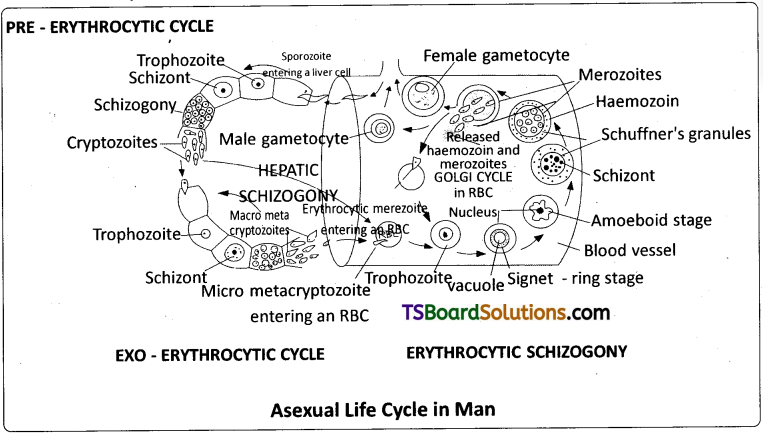
Question 3.
Describe the life cycle of Plasmodium vivax in mosquito.
Answer:
Life cycle of Plasmodium in mosquito (The mosquito phase)- Ross cycle: When a female Anopheles mosquito bites and sucks the blood of a malaria patient, the gametocytes along with the other stages of the erythrocytic cycle reach the crop of mosquito. Here all the stages are digested except the gametocytes. Further part of the life cycle consists of:
- Gametogony
- Fertilization
- Formation of Ookinete & Oocysts
- Sporogony
i) Gametogony :
The formation of male and female gametes from the gametocytes is called gametogony. It occurs in the lumen of the crop of mosquito.
Formation of male gametes :
During this process, the nucleus of microgametocyte divides into eight daughter nuclei called pronuclei which reach the periphery. The cytoplasm is pushed out in the form of eight flagella like processes. Into each flagellum like process, one pronucleus enters and forms a micro gamete or male gamete. These male gametes show lashing movements like flagella and get separated from the cytoplasm of microgametocyte. This process is called exflagellation.
Formation of female gamete :
The female gametocyte undergoes a few changes and transforms into a female gamete. This process is called maturation. The nucleus of the female gamete moves towards the periphery and the cytoplasm at that point forms a projection. This projected region is called the fertilization cone.
ii) Fertilization :
The fusion of male and female gametes is called fertilization. It also occurs in the lumen of the crop of the mosquito. When an actively moving male gamete comes into contact with the fertilization cone of the female gamete, it enters it. The pronuclei and cytoplasm of these two gametes fuse with each other, resulting in the formation of a synkaryon. Since the two gametes are dissimilar in size, this process is known as anisogamy. The female gamete that bears the synkaryon is called the zygote which is round and non – motile.
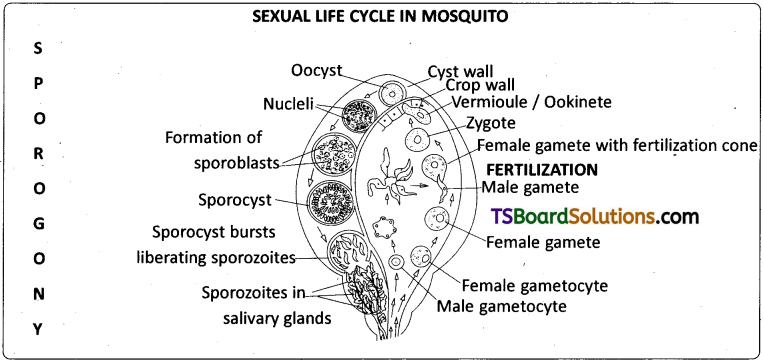
iii) Formation of ookinete and oocysts :
The zygote remains inactive for some time and then transforms into a long, slender, motile, vermiform ookinete or vermicide within 18 to 24 hours. It pierces the wall of the crop and settles beneath the basement membrane. It becomes round and secretes a cyst around its body. This encysted ookinete is now called oocyst. About 50 to 500 oocysts are formed on the wall of the crop and appear in the form of small nodules. (Sir Ronald Ross identified these oocysts for the first time).
iv) Sporogony :

The formation of sporozoites in the oocysts is called sporogony. According to Bano, the nucleus of the oocyst first undergoes reduction division followed by repeated mitotic divisions resulting in the formation of about 1,000 daughter nuclei. Each bit of nucleus is surrounded by a little bit of the cytoplasm and transforms into a sickle shaped sporozoite. Oocyst with such sporozoites is called sporocyst. When this sporocyst ruptures, the sporozoites are liberated into the haemocoel of the mosquito. From there, they travel into the salivary glands and are ready for infection. The life cycle of Plasmodium in mosquito is completed in about 10 to 24 days.
![]()
Question 4.
Describe the structure and life cycle of Ascaris lumbricoides with the help of a neat and labelled diagram.
Answer:
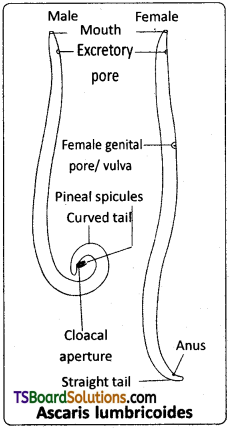
Structure :
Sexes are separate and the sexual dimorphism is distinct. In both males and females, the body is elongated and cylindrical. Mouth is present at the extreme anterior end and is surrounded by three chitinous lips. Close to the mouth mid ventrally, there is a small aperture called excretory pore.
Male :
It has a curved posterior end which is considered the tail. The posterior end possesses a cloacal aperture and a pair of equal sized chitinous ‘pineal spicules or ‘pineal setae which serve to transfer the sperms during copulation.
Female :
It has a straight posterior end, the tail. The female genital pore or vulva is present mid ventrally at about one third the length from mouth. The anus is present a little in front of the tail end.
Life history :
Copulation takes place in the small intestine of man. After copulation, the female releases approximately two lakh eggs per day. Each egg is surrounded by ‘a protein coat with rippled surface. Hence the eggs of Ascaris are described as mammillated eggs. The protein coat is followed by a chitinous shell and a lipid layer internally. These eggs come out along with faecal matter. In the moist soil, development takes place inside the egg so that the 1st stage rhabditiform larva is produced. It undergoes the 1st moulting and becomes the 2nd stage rhabditiform larva which is considered ‘the stage infective to man’. They reach the alimentary canal of man through contaminated food and water.
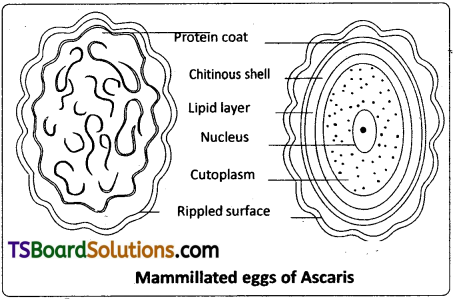
In the small intestine, the shell gets dissolved so that the 2nd stage larva is released. Now it undergoes extra intestinal migration. First it reaches the liver through the hepatic portal vein. From there it reaches the heart through the post caval vein. It goes to the lungs through the pulmonary arteries. In the alveoli of lungs it undergoes the 2nd moulting to produce the 3rd stage larva. It undergoes the 3rd moulting so that the 4th stage larva is produced in the alveoli only. It leaves the alveoli and reaches the small intestine again, through bronchi, trachea, larynx, glottis, pharynx, oesophagus and stomach. In the small intestine, it undergoes the 4th and final moulting to become a young one which attains sexual maturity within 8 to 10 weeks.
Pathogenicity :
The disease caused by Ascaris lumbricoides is called ascariasis. The disease is asymptomatic if the number of worms is less. A heavy infection causes nutritional deficiency and severe abdominal pain. It also causes stunted growth in children.
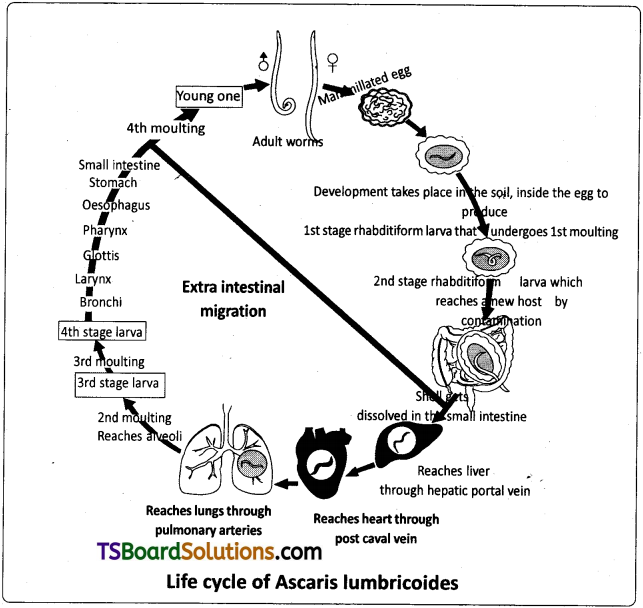
Question 5.
Describe the life cycle of Wuchereria bancrofti.
Answer:
Life Cycle :
Wuchereria bancrofti completes its life cycle in two hosts namely man and female culex mosquito.
In man :
Both male and female worms are found coiled together in the lymphatic vessels of man. After copulation the female releases the sheathed microfilaria larvae into the lymph of man. Each sheathed microfilaria larva measures 0.2 to 0.3 mm in length. It is surrounded by a loose cuticular sheath which is supposed to be the modified shell. They migrate to the blood circulation and reside in the deeper blood vessels during the day time. They move to the peripheral blood circulation during the night time between 10.00 pm and 4.00 am. This tendency is referred to as nocturnal periodicity. When a female Culex mosquito sucks the blood of an infected person, they enter the gut of mosquito. They die if they are not transferred to mosquito with in 70 days.
In mosquito :
In the mid gut of mosquito, the sheath of the larva is dissolved within 2 to 6 hours of the infection. The ex-sheathed microfilaria larva penetrates the gut wall and reaches the haernocoel of mosquito. From there, it reaches the thoracic muscles and transforms into a ‘sausage shaped larva within two days. It is called the first stage larva or first stage microfilaria. This undergoes two moultings within 10 to 20 days and transforms into a long, infective 3rd stage microfilaria. It reaches the labium of the mosquito.
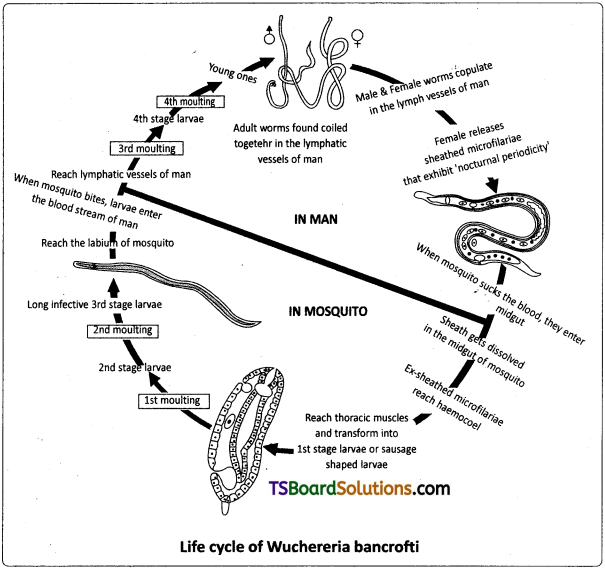
In man after the infection :
When an infected mosquito bites a man, the 3rd stage microfilaria larvae enter the blood circulation of man and finally reach the lymphatic vessels. Here they undergo the 3rdand the 4th moultings to produce young filarial worms. They attain sexual maturity within 5 to 18 months.
![]()
Question 6.
Write an essay on adolescence and TDA abuse.
Answer:
Adolescence and TDA abuse:
Adolescence :
It is the time period between the beginning of puberty and the beginning of adulthood. In other words, it is the bridge linking childhood and adulthood. The age between 12 -18 years is considered adolescence period. It is both ‘a period and a process’ during which a child becomes mature. It is accompanied by several biological and behavioural changes. Thus, adolescence is a very vulnerable phase of mental and psychological development of an individual.
TDA abuse :
Curiosity, desire for adventure and excitement, experimentation, are the common causes for the motivation of youngsters towards the use of tobacco, drugs and alcohol. The first use of drugs or alcohol may be out of curiosity or experimentation, but later the person starts using them to escape facing problems. Recently ‘stress from the pressure to excel in academics or examinations’ has played a significant role in alluring the youngsters to try certain drugs. Television, movies, newspapers and internet also help promoting this wrong perception. Other factors that are associated with tobacco, drug and alcohol abuse among adolescents are unstable or unsupportive family structures and peer pressure.
Addiction and Dependence :
The TDA abuse leads to addiction and dependence.
Addiction :
It is a psychological attachment to certain effects such as euphoria. The most important thing one fails to realise is, the inherent addictive nature of tobacco, drugs and alcohol. With the repeated use of TDA, the tolerance level of the receptors present in our body increases. Consequently the receptors respond only to higher doses leading to greater intake and addiction. However it should be clearly borne in mind that use of TDA even once, can be a fore-runner to addiction. Thus, the addictive potential of tobacco, drugs and alcohol pull the users into a vicious circle leading to their regular use (abuse) from which they may not be able to get out. In the absence of any guidance or counselling, people get addicted and become dependent on them.
Dependence :
It is the tendency of the body to manifest a characteristic and unpleasant condition (withdrawal syndrome) if the regular dose of drugs or alcohol is abruptly discontinued. The withdrawal syndrome is characterised by anxiety, shakiness (tremors), nausea and sweating which may be relieved when the regular use is resumed again. Dependence leads the patients to ignore all social norms.
Adverse effects of drugs and alcohol abuse :
The immediate adverse effects of drugs and alcohol abuse are manifested in the form of reluctant behaviour, vandalism and violence. Excessive doses of drugs may lead to coma and death due to respiratory or heart failure or cerebral haemorrhage. A combination of drugs or their intake along with alcohol generally results in overdosing and even death. The most common warning signs of drug and alcohol abuse among the youth include drop in academic performance, lack of interest in personal hygiene, depression, fatigue, aggressive behaviour, loss of interest in hobbies, change in sleeping and eating habits, fluctuations in weight, appetite, etc.
Those who take drugs intravenously are much more likely to acquire serious infections such as HIV, HBV (Hepatitis – B virus) etc., as the viruses are transferred from one person to another by the sharing of infected needles and syringes. The chronic use of drugs and alcohol damages nervous system and liver. The use of drugs and alcohol during pregnancy is also known to affect the foetus adversely.
Some sports-persorTs take drugs such as anabolic steroids to enhance their performance. The side-effects of the use of these drugs in females include masculinisation, increased aggressiveness, mood swings, depression, abnormal menstrual cycles, excessive hair growth on the face and body and the enlargement of clitoris. In males it includes acne (pimples), increased aggressiveness, mood swings, depression, reduction in the size of testicles, decreased sperm production, kidney and liver dysfunction, enlargement of breasts, premature baldness and the enlargement of the prostate gland.
Prevention and Control :
The age-old adage of Prevention is better than cure holds true here also. Some of the measures useful for prevention and control of TDA abuse among the adolescents are :
i) Avoid undue parental pressure :
Every child has his / her own choice, capacity and personality. The parents should not force their children to perform beyond their capacity by comparing them with others in studies, games, etc.
ii) Responsibility of parents and teachers :
They should look for the danger signs and counsel such students who are likely to get into the ‘trap’.
iii) Seeking help from peers :
If peers find someone abusing drugs or alcohol, immediately it should be brought to the notice of their parents or teachers so that they can guide them appropriately.
iv) Education and counselling :
Educating and counselling the children to face problems, stress and failures as a part of life.
v) Seeking professional and medical help:
A lot of help is available in the form of highly qualified psychologists, psychiatrists and de-addiction and rehabilitation programmers.